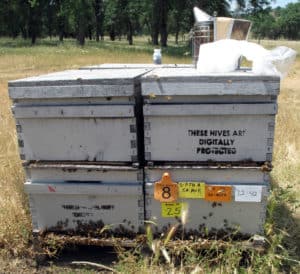The summer sampling period began 10 days ago with the sixteen beekeepers participating in the Bee Informed Partnership. This sampling period places an emphasis on determining Varroa mite and Nosema levels prior to beekeepers treating with medicines this year. Most beekeepers will try to have their mite treatments in 30 days prior to the nectar flow. Out here the flow begins in July when the star thistle blooms. Treatment windows are narrow, making timing and balance critical.
One of the many benefits of our program is that we help to provide beekeepers with a history of their hives by inspecting and sampling some of them numerous times throughout the year. Our three major sampling periods are in the spring (January-March), summer (June-July), and fall (Sept-Nov). Each hive that is inspected and sampled is tagged with a number and date so that both we and the beekeepers can match inspection and lab data back to the corresponding hive. Seeing a beekeepers hive with multiple tags stapled to the front means that we have inspected and sampled it numerous times in the past. As long as the hive retains the queen from the date of the initial inspection then we leave the tags on and add a new one. If a queen event occurs (i.e. death, swarm, superscedure,) the tags are removed and the hive is replaced and as they say the hive becomes “history”. The picture below was taken last week during field work. This particular hive has five tags on it. Four of the tags were put there by our team and one was placed on the hive by the beekeeper.

This particular hive was one that was marked up by the beekeeper throughout the year because of its desirable traits and therefore it’s potential to be used as a breeder in 2012. Those traits usually include honey production, population, temperament, egg viability or brood pattern, color, and its ability to over-winter and build up in the spring. Because this hive scored well in all of the categories above, this beekeeper wanted to know more about the hive… This is where we come in.
We inspected and sampled the hive in November 2011 to assess it for strength and determine its Varroa mite and Nosema levels. It was then tested again in December for protein content. The beekeeper liked this hive enough to keep it in their pool of potential breeders maintaining close surveillance to observe how it over-wintered and built up in the spring. Because it came through the winter well and built up fast the beekeeper chose it to be assessed and sampled again by our team in February 2012 as a potential breeder. Testing in February for potential breeders includes sampling for Varroa and Nosema but also testing the bees for their degree of hygienic behavior.
Below are two tables that summarize the data from our inspections and lab work. This hive never did end up making the final cut as a breeder but is still a hell of a hive. This just goes to show how much scrutiny a beekeeper in our group puts his hive through to become a breeder. I can only guess as to why it didn’t make it to this beekeepers breeding yard but it could have been due to a slight touch of Nosema last fall…By the way this hive was also tested for the National Honey Bee Survey which includes another Varroa and Nosema test along with a viral analysis that incorporates testing for 8 viruses (we do not have access to the results of the National Honey Bee Survey for individual beekeepers). I would challenge anyone to find a breeder anywhere else in the country that has his or her hives tested by someone other than themselves as many times as the sixteen beekeepers participating in the Bee Informed Partnership.

